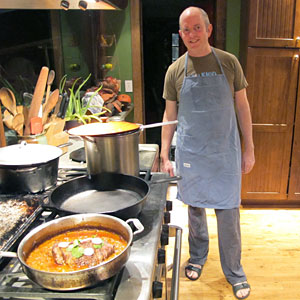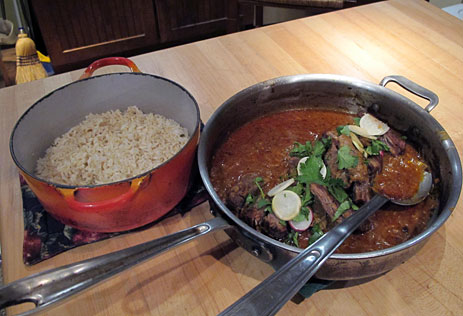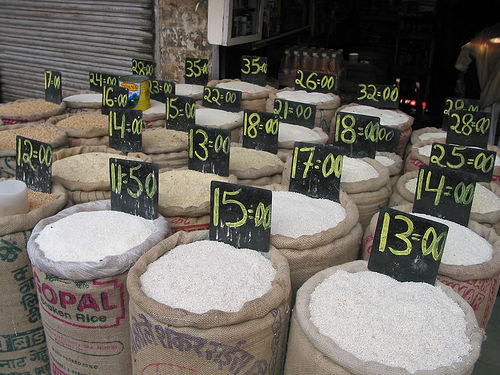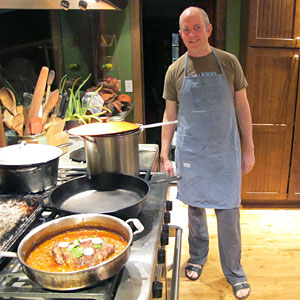 The chef in his kitchen. Editor’s note: Those are not OSHA approved footwear. Photo: Alice Brooke RecentlyRecently, I was suddenly confronted with a bounty of meat to cook: a pair of big pork chops, a pound of ground beef, and a pound and half of boneless chuck roast, all thawed and ready to go, all from excellent, pasture-based producers within an hour’s drive from my home.
The chef in his kitchen. Editor’s note: Those are not OSHA approved footwear. Photo: Alice Brooke RecentlyRecently, I was suddenly confronted with a bounty of meat to cook: a pair of big pork chops, a pound of ground beef, and a pound and half of boneless chuck roast, all thawed and ready to go, all from excellent, pasture-based producers within an hour’s drive from my home.
Normally, my household of three adults goes through this much meat in about two weeks. To avoid spoilage, we pretty much had to consume it in just a few consecutive days.
How had this happened to us? Well, the project I help run, Maverick Farms in Valle Crucis, N.C., runs a multi-farm CSA called High Country CSA. (CSA stands for Community-Supported Agriculture. Grist’s own Umbra delivered a nice description of the CSA model a couple of years ago.)
To make a long story short, whenever you’re serving as the go-between for more than 10 farms and dozens of consumers, mix-ups are going to happen. And one recent Saturday, the first pickup for our winter-season CSA, somehow the above-mentioned list of meat didn’t get picked up. Then it spent the night in a cooler without ice, causing it to thaw. And that’s how I found myself on the hook to cook and eat lots of meat in just a few days.
Like a USDA bureaucrat wondering how to help agribusiness turn a torrent of cheap milk into a profitable product, I needed a fast-and-dirty way to deal with with a surplus. Oh, the irony.
I decided to stretch my repertoire and make dishes I rarely make. The pork chops I seared and then braised in onions, soy sauce, and rice vinegar, nodding to the “Chinese pork chops” my mom sometimes made when I was a kid. The ground beef, I transformed into baked ziti, an homage to Carmela Soprano on the occasion of watching the series finale of The Sopranos on DVD last week.
As for the chuck roast, I turned to Thailand for inspiration. I should emphasize that there’s nothing “authentic” about the dish that follows. I used a classic French technique — sear and then braise a tough cut of beef like chuck until it’s fork tender — and jazzed it up with some Thai-ish ingredients.
I also did something I typically avoid, but not religiously: I used a jarred curry paste rather than making my own from scratch. Hey, homemade Thai curry is a complex process; and it was Tuesday night in the middle of a hectic week. The product I used — Thai Kitchen’s red curry paste — is pretty good, especially when goosed with fresh onions, ginger, and chile.
 Thai curried beefBeef braised in red-curried coconut milk
Thai curried beefBeef braised in red-curried coconut milk
Feeds three generously.
1 boneless chuck roast from a grass-fed cow, rinsed and dried thoroughly with a towel (wet meat doesn’t brown very well), and sprinkled all over with salt and pepper
Coconut oil to sear the meat and sauté onions (regular vegetable oil works fine, too)
3 small onions, sliced thin
2 to 3 cloves garlic, crushed, peeled, and minced
1 knuckle-sized nob of ginger, peeled and minced
1 fresh red chile pepper (optional; I want the clear sting of fresh chile in this dish), minced
1 to 2 ounces Thai Kitchen red curry paste
I can of organic cocunut milk (plus an extra can on hand, just in case — see below)
Salt and pepper to taste
Chopped cilantro and sliced radishes, for garnish
Preheat oven to 300. In a frying pan with an oven-safe cover, add a tablespoon of coconut oil and heat over medium-high heat. When the oil has melted and is very hot, sear the chuck roast on all sides, until browned all over. Remove the roast from pan and set aside on a plate.
Turn heat to medium, add a bit bit more coconut oil, and add the onions. Saute them them, stirring often, for several minutes. When they’ve begun to soften, add a couple of spoonfuls of curry paste, stir to coat the onions thoroughly. (If you’re shy about spicy-hotness, one tablespoon; if daring, two.) Let them continue sauteing for a minute or two, stirring often, to let the curry paste toast.
Lower the heat a bit and add the minced garlic, ginger, and chile (if using). Let it all saute gently for another minute or two.
Now stir in all of the coconut milk, and add the browned roast. Cover, and place in preheated oven. Now forget about it for at least three hours.
Enjoy the magical spicy/beefy aroma that perfumes the kitchens. Start checking it occasionally once the three-hour mark hits. It is done when the roast is absolutely fork- tender; don’t rush it. Remove roast from pan and place it on a cutting board. Taste the sauce for salt; correct if need be. If it is so spicy it knocks you over, add more coconut milk in small increments until it is properly tamed. Slice the beef gently into thick pieces, return it to the pan with the curry sauce, and garnish with cilantro. I served it with brown rice, a green salad, and cans of Ska Modus Hoperandi beer.



